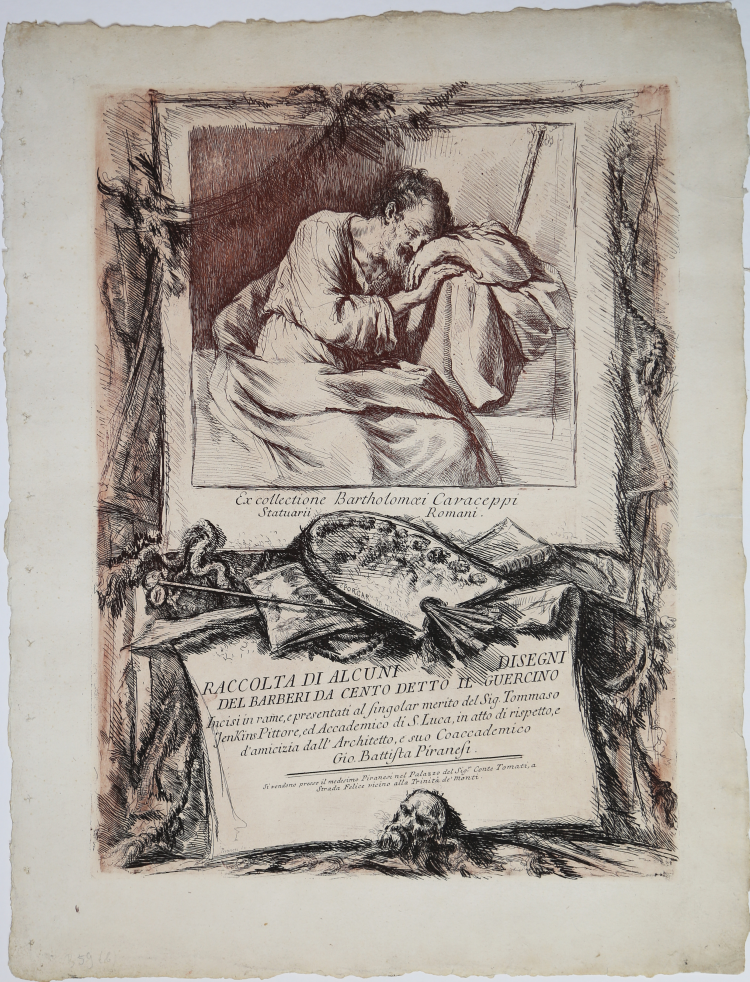





| Reference: | S37092 |
| Author | Giovan Battista PIRANESI |
| Year: | 1764 ca. |
| Measures: | 362 x 484 mm |




| Reference: | S37092 |
| Author | Giovan Battista PIRANESI |
| Year: | 1764 ca. |
| Measures: | 362 x 484 mm |
Etching and engraving, with red and black ink, 1764. Inscribed under the image “Ex collectione Bartholomoei Cavaceppi Statuarii Romani”; below: “RACCOLTA DI ALCUNI. DISEGNI DEL BARBERI DA CENTO DETTO IL GUERCINO Incisi in rame, e presentati al. singolar merito del Sig. Tommaso Jankins Pittore, ed Accademico di S. Luca, in. atto di rispetto, e d'amicizia dall' Architetto, e suo Coaccademico Gio.. Battista Piranesi. Si vendono presso il medesimo Piranesi nel Palazzo del sigr.. Conte Tomati, a Strada Felice vicino alla Trinita de' Monti”.
Magnificient example, printed on contemporary laid paper, with watermark, uncut, in very good condition.
Title-page of the series “Raccolta di alcuni disegni del Barberi da Cento detto il Guercino…”.
The title page was dedicated by Piranesi to Thomas Jenkins, an English merchant member of the Academy, including the reproduction of a drawing by Guercino depicting St. Jerome, formerly in the collection of the restorer Bartolomeo Cavaceppi.
This unusual series of engravings after drawings by Guercino, Pier Leone Ghezzi and others, is the result of an editorial initiative of Piranesi. The idea of the volume must be created by the purchase of plates that Bartolozzi performed in Venetian and Bologna collections before leaving Italy for London. Piranesi, expanding the project, added other plates that commissioned to engravers like Giovanni Ottaviani and Jacques Nevay.
The work was realized in Rome translate into engravings the original drawings own by members of the Accademia of San Luca. Probably then the individual engravings were assembled on demand of the buyer, as evidenced by the fact that each collection is different from the other for number of plates. The corpus consists of the graphic engravings by Bartolozzi, which reproduce the original drawings from the collection of Joseph Smith, Giovanni Battista Tiepolo, and the Count Antonio Maria Zanetti.
Bibliografia
A. Bettagno, Piranesi, pp. 53-55; Wilton Ely p. 1108, n. 1015.
Giovan Battista PIRANESI (Mogliano Veneto 1720 - Roma 1778)
|
Italian etcher, engraver, designer, architect, archaeologist and theorist. He is considered one of the supreme exponents of topographical engraving, but his lifelong preoccupation with architecture was fundamental to his art. Although few of his architectural designs were executed, he had a seminal influence on European Neo-classicism through personal contacts with architects, patrons and visiting artists in Rome over the course of nearly four decades. His prolific output of etched plates, which combined remarkable flights of imagination with a strongly practical understanding of ancient Roman technology, fostered a new and lasting perception of antiquity. He was also a designer of festival structures and stage sets, interior decoration and furniture, as well as a restorer of antiquities. The interaction of this rare combination of activities led him to highly original concepts of design, which were advocated in a body of influential theoretical writings. The ultimate legacy of his unique vision of Roman civilization was an imaginative interpretation and re-creation of the past, which inspired writers and poets as much as artists and designers.
|
Giovan Battista PIRANESI (Mogliano Veneto 1720 - Roma 1778)
|
Italian etcher, engraver, designer, architect, archaeologist and theorist. He is considered one of the supreme exponents of topographical engraving, but his lifelong preoccupation with architecture was fundamental to his art. Although few of his architectural designs were executed, he had a seminal influence on European Neo-classicism through personal contacts with architects, patrons and visiting artists in Rome over the course of nearly four decades. His prolific output of etched plates, which combined remarkable flights of imagination with a strongly practical understanding of ancient Roman technology, fostered a new and lasting perception of antiquity. He was also a designer of festival structures and stage sets, interior decoration and furniture, as well as a restorer of antiquities. The interaction of this rare combination of activities led him to highly original concepts of design, which were advocated in a body of influential theoretical writings. The ultimate legacy of his unique vision of Roman civilization was an imaginative interpretation and re-creation of the past, which inspired writers and poets as much as artists and designers.
|